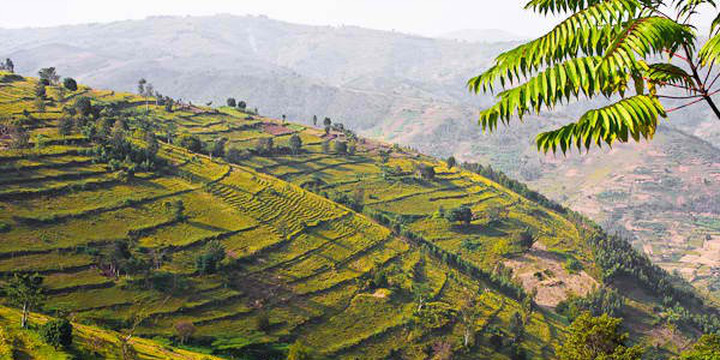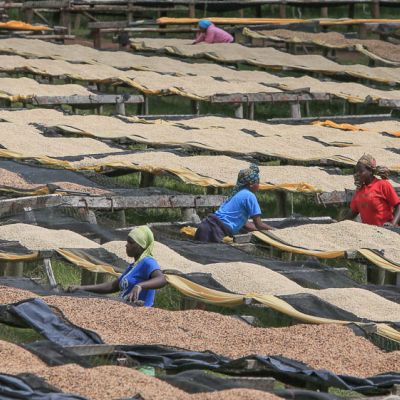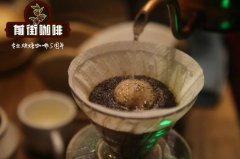The fire Phoenix reborn after robbery! Drink a cup of coffee from Rwanda for peaceful development
Professional coffee knowledge exchange More coffee bean information Please pay attention to coffee workshop (Weixin Official Accounts cafe_style)
When you think of Rwanda, the first thing you might think of is the Rwandan genocide, a tragedy that happened in 1994, just 25 years ago. In just 100 days, ethnic conflicts killed about 800,000 people. Ten years after the tragedy, in 2004, a moving classic film "Hotel Rwanda" based on real people was filmed, which won many awards that year.
Against this background, many people may still think that Rwanda is still a dilapidated, backward and poor country. But...

Since President Kagame took office, the annual GDP growth rate has been as high as 8% since 2002. The country with the highest proportion of female parliamentarians in the world, Kagame visited the United States in 2006 and successfully sold Rwandan coffee to Costco and Starbucks. President Kagame is a descendant of Tutsi who was almost exterminated, but he led his people to put down ethnic hatred and reverse the fate of the country.
Because of political stability, talent cultivation and equipment investment invested by international organizations began to sprout in the coffee industry. Over the years, the output and output value of Rwandan coffee have doubled, the quality has been continuously improved, and awards have been continuously won in the international fine coffee market.
Rwandan coffee beans
Rwanda has always been blessed with good coffee growing conditions: high altitude, volcanic soil, abundant sunlight and cabernet sauvignon. Rwanda is also known as the "country of a thousand mountains" because many coffee trees are grown in the mountains between 1700 and 2000 meters above sea level.

Rwandan coffee is a world-class treat, balanced in taste compared to Kenyan coffee and clear in place to rival Central American coffee. Rwandan coffee generally has sweet fruit, floral notes and a dark tea finish. Coffee production lines tend to operate in a country-dependent manner, whereas coffee in Rwanda is produced exclusively by smallholders rather than large-scale enterprises. Compared to farms in Brazil, even small ones amount to 20 hectares. Rwanda's 0.1-0.2 hectares are insignificant.
Here, farmers pick coffee beans from coffee trees by hand, then send them to a processing station, where they are trampled by barefoot, singing farmers. These coffees are sweet, with clear lemon notes and subtle berry and chocolate flavors.
For these developing countries, coffee naturally becomes one of the main development directions of the country as demand for specialty coffee increases after it has attracted attention, in order to continuously improve and gain recognition in the international market.
After the beans are separated from the fruit, the farmer sorts them individually with a rake and water, and then sunburns them. Because coffee beans are sensitive to humidity, farmers rush to cover them with tarpaulins whenever a breeze blows.
Rwandan coffee flavor
Bourbon accounts for more than 90% of Rwanda's production. A small number of farmers planted Bourbon varieties BM-139 and Jackson. Rwandan coffee tastes vary widely: cherries, raisins, limes, kungfu, cantaloupes, oranges, honey, candy, apricots, plums, etc.
In fact, the taste of these fruits is the certification of good growing conditions. According to the National Agricultural Export Development Board, there are currently about 400,000 small production units in Rwanda, and agricultural land is generally located at an altitude of 1,700- 2,000. Most of the country's coffee production comes from the west and south, but there are actually five regions where it is produced. In the southwest, Virunga in the volcanic region is dominant, and the famous Sliverback mountain is also here. To the west of the country there is Kivu district next to Lake Kivu. As for the central part of the country, there is the Kizi Rift district. Then go to the southern end of the map and you will find Akagera at a lower elevation, about 1300 degrees. Finally, to the east lies the Muhazi region.
Although the characteristics of the regions vary, generally speaking, the regions of Rwanda are of high elevation and volcanic soils with high nitrogen content. To come up with high-quality coffee, these conditions are naturally indispensable.
coffee processing
Once upon a time, coffee was handled differently on each farm, and beans from different farms would come together and mix with neighbors.
After the genocide, the country began to open up to foreign aid and revitalizing the coffee industry became a national priority. As a result, PEARL and SPREAD programs began to emerge in China to provide consistent training for coffee farmers and to establish washing plants to match traditional coffee processing methods in East Africa. Burundi is one of those countries that uses this approach to its fullest.
Another noteworthy feature is the African fully washed double washing process, which involves soaking coffee beans twice, a practice that is not common in Latin America.
The most commendable thing about Rwandan coffee is that after the coffee cherries are harvested, the coffee farmers will first select the green cherries that are not ripe. Then, the ripe cherries are separated in the washing tank, and only the red cherries are sent to the husker. Depending on the weather conditions at the time, coffee cherries with residual pectin will ferment for 24-48 hours. The purpose of fermentation is to avoid spoiling the coffee flavor. Then send the clean coffee beans with the remaining sheepskin to dry. All coffee is dried on a net bed for 15-22 days, leaving about 11% moisture. When the weather is too hot, canons must cover them with cloth, otherwise the drying process will be completed prematurely.

The best Rwandan parchment coffee should have a white coating and no cracks if the drying process is completed properly. This allows more organic compounds to be retained, and the shelf life can be extended while the taste is good.
Rwandan coffee beans grown at high altitudes are generally sweet and dense when treated with full water washing.
END
Important Notice :
前街咖啡 FrontStreet Coffee has moved to new addredd:
FrontStreet Coffee Address: 315,Donghua East Road,GuangZhou
Tel:020 38364473
- Prev

2019BOP Competition Champion Manor Erida Manor Panama introduction Alida Rosa Coffee introduction
Professional coffee knowledge exchange more coffee bean information please follow the coffee workshop (Wechat official account cafe_style) in 1996, Panama founded the first Panamanian raw bean competition the best Panama (Best of Panama, hereinafter referred to as BOP), now, BOP as a Panamanian raw bean event, can also be regarded as the annual event of the coffee industry all over the world. This year, 2019 BOP in Pakistan
- Next

What is the sunrise plan for Bolivian coffee? Introduction of Saint Angel Manor Caravani, Bolivia
Professional coffee knowledge exchange more coffee bean information please follow the coffee workshop (Wechat official account cafe_style) Bolivia's "tomorrow Sun Project", that is, a plan to comprehensively promote Bolivian coffee, which requires a lot of money and effort to coach small farmers, including technical support, breeding, pruning, harvesting and other important technologies, and buy small farmers at high prices.
Related
- Detailed explanation of Jadeite planting Land in Panamanian Jadeite Manor introduction to the grading system of Jadeite competitive bidding, Red bid, Green bid and Rose Summer
- Story of Coffee planting in Brenka region of Costa Rica Stonehenge Manor anaerobic heavy honey treatment of flavor mouth
- What's on the barrel of Blue Mountain Coffee beans?
- Can American coffee also pull flowers? How to use hot American style to pull out a good-looking pattern?
- Can you make a cold extract with coffee beans? What is the right proportion for cold-extracted coffee formula?
- Indonesian PWN Gold Mandrine Coffee Origin Features Flavor How to Chong? Mandolin coffee is American.
- A brief introduction to the flavor characteristics of Brazilian yellow bourbon coffee beans
- What is the effect of different water quality on the flavor of cold-extracted coffee? What kind of water is best for brewing coffee?
- Why do you think of Rose Summer whenever you mention Panamanian coffee?
- Introduction to the characteristics of authentic blue mountain coffee bean producing areas? What is the CIB Coffee Authority in Jamaica?

